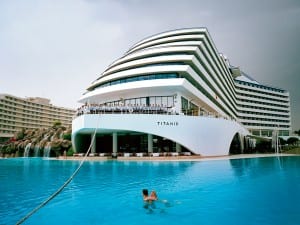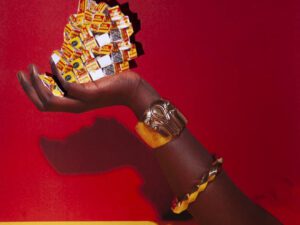Luxembourg & Dayan’s The End of Collage, curated by Yuval Etgar, is a captivating survey highlighting the breadth of collage in the 20th century. Taking place in their London and New York galleries, the London iteration focuses on the three distinct themes – the domestic space, dismemberment of the body and the reframing of reality – that Etgar believes characterises collage throughout this period.
As soon as you walk through the door you are confronted by the pairing of Joan Miro’s Métamorphose (1936) and Nusch Eluard’s Untitled (1936). Each work ushers in two differing starting points for collage: Miro’s is born out of his principle practice of painting, while Eluard’s, is rooted in the mechanics of photographic reproduction.
At just 13 x 8.5 cm, Untitled, consists of a black and white cut-out of naked woman curving around the bottom right corner of the very pale green background as her arms extend up towards the top left corner. Behind her, a mishmash of landscape features can be seen -–the withered branches of a tree and a blurred hill line – which further add to the surreal, dreamlike scene as a cherub-like figure hovers over her, spellbound by her movements, and a fish aimlessly swims beneath. Métamorphose is larger and horizontal in composition. Its focal point is a web of black ink marks in the centre and features, to the left of this, a rudimentary profile of a figure in pencil. Scattered around the composition are decals of animals and sunbathers as well as gestural swipes of watercolour offering flickers of colour that suggest it’s an experimental exercise for what will become his acclaimed constellation series of paintings completed between 1939 and 1941.
This is not to say that collage will always played second fiddle in an artist’s oeuvre. As a medium, its conceptual capabilities can be seen, most notably, it can be argued, with Richard Prince. In the work exhibited here, Untitled (Living rooms) I – V (1977), is one of Prince’s earliest forays into photographic appropriation; a talent that has since indelibly put his name into the cannon of art history as he continues to lead one of the most provocative careers in contemporary art. It features four seductive and unauthored photographs of stage-sets of chic living rooms that have been clipped from a furniture advertisement campaign featured in the New York Times Magazine aimed exclusively at the upper echelons of society. Prince has edited the advertisements so that just the image remains which he has then re-photographed and enlarged.
Prince happened along the idea while working for Time Life, clipping articles from the magazine for staff writers leaving the advertisements behind. It is here that Prince noticed different companies employing very similar motifs and visual devices to bolster their advertisements. The idea that these works are then exhibited in a contemporary art gallery seems to both pander to and poke fun at the audience unabashedly echoing the nonchalance when Prince appropriated the original image.
On the other side of the gallery, Jack Goldstein’s 16 mm film projection The Jump (1975) pushes the boundaries of collage as a medium by using the then-new technique of rotoscoping. It also, however, signifies the rise of its successor – a precursor to digital manipulation and moving image. The film shows the silhouette of a diver in pulsing gold and orange dots as they dive into the empty dark blue background of the projection. The protagonist’s confident dives and summersaults allure your gaze like the traces of fireworks in the night sky. But as the video loops over and over again, a feeling of melancholy washes over the work; the diver is trapped destined to live out the same pattern of movements.
To its right is Richard Hamilton’s Fashion-plate (Cosmetic Study XI) (1969). It is a perfect example of Hamilton’s ability to marry figurative painting with the polished showroom perfection signature to consumer culture at the time. The work shows the frankensteining of a woman through various photographic cuttings of women’s features and painted segments framed by the lighting equipment of a photoshoot. Time and again, Hamilton’s work undercuts the devices and strategies of advertising and self-image that still loom dominantly over society today. Because of this, the eyes, which are darting to the right, beyond the physical ends of the composition, as if they are pleading for help echoing the doomed the doomed trappings of Goldestein’s diver. While actively embracing the socio-cultural impact of photographic reproduction, Hamilton’s painterly touch is never overcome no matter how subtle it is and, as such, this work acts as a logical stepping stone between the Miro’s painterly experiments and Prince’s exclusively photographic based work.
Yet the standout works in the show are seen in the section concerned with the reframing of reality. Along a pale pink wall is a series of seven framed John Stezaker collages. At once humorous and absurd in their reading, they deftly exemplify Stezaker’s career long examination and mastering of the medium of collage where one action can have maximum impact. “Collage”, says Stezaker, “is about interrupting the seam and making something illegible.” For example, in Kiss XIV (2015), a film still showing a man and woman dressed in formal evening wear lean in for a kiss. Stezaker teases the you by placing a sepia toned postcard of a pathway between two tall rock faces obscuring the kiss and their features. Such are the contours of the rock faces though, you can comically interpret them as elementary outlines of where the nose or jaw-line might be. In front of these, are four vitrines that display Max Ernst’s Une Semaine de Bonté (1933 -1934). In each vitrine is a booklet with prints of illustrations found in Victorian Encyclopaedias and novels. Each page is assigned a day of the week. The illustrations are bombastic, and are, just like Stezaker’s works behind it, absurd in their reading. There is no obvious correlation from one illustration to the next other than this absurdity which depicts a collision between bacchanalian hedonism and mythological metamorphosis that is darkly laughable.
It is now that you notice, on the wall next to the doorway where you came into the gallery, Mark Flood’s wryly acidic The Little Prince (1984). Inside a frame is a ripped photo of the Royal Family with only Prince Charles visible, holding his son in his lap whose face Flood has crudely replaced with a different baby’s covered in brown smears and pulling a goofy expression. Wildly wicked, it’s like an obscene joke that forces a laugh. And it becomes apparent, that these works are unified by their ability, at times ham-fistedly, to create, just for a split second, a new reality. It is a unique characteristic, exemplified by this touching exhibition, that can only be expertly executed from collage.
William Davie
The Ends of Collage ran from 27 February to 6 May at Luxembourg & Dayan, New York. For more information: www.luxembourgdayan.com
Credits:
1. John Stezaker (b. 1949) Arch I, 1980. Collage, 10 x 81/8 in. (25.4 x 20.7 cm.). © The artist, 2017. Courtesy The Approach London. Photo: FXP Photography.





